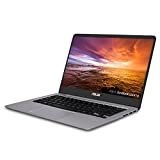Asus’ UX300 series laptops have always impressed us with their mix of premium looks and top-quality screens. With the UX410 series, Asus ups the screen size to 14in but retains the rest of the formula – and with similarly top-quality results.
Let’s start with the premium looks. The brushed aluminium lid would be equally at home on a laptop twice the price, and it’s complemented by a sunken touchpad complete with a shiny metal “diamond-cut” edge. To some, the UX410 may veer too far into a Trump-like world of bling, particularly if you choose the Rose Gold finish, but I’m a fan.
READ NEXT: The best laptops you can buy in the UK
Considering the 14in screen, it’s also surprisingly light at 1.4kg. That’s not due to plastic, either, with the frame built from aluminium alloy, and it feels suitably well-built. By trimming the bezels on either side of the screen to 6mm, Asus keeps the width down to 323mm, but by modern standards it isn’t particularly slim: I measured 19mm from top to bottom with the lid closed.
A larger chassis provides more room for ports, though, and the UX410 is well connected. Along with a combo audio jack, there’s a full-sized HDMI connector plus USB 3.1 and USB Type-C ports on the left-hand side. An SD card slot and two further USB 2 ports sit on the right. Asus tucks the speakers under the front lip of the laptop, and they’re worthy of the Harman Kardon branding – loud, clear and detailed.


But where Asus truly excels is that screen. For instance, there’s no off-white discolouring that gives away cheaper panels, and as became clear during a sunny train journey, it dynamically adjusts brightness to the ambient conditions.
A resolution of 1,920 x 1,080 makes complete sense on a laptop such as this: there’s enough detail for spreadsheets and zooming into photos, but you aren’t paying for a higher resolution that you may not always want (especially when Windows decides to show system text at the smallest possible size).
Colours look punchy, and my first impressions were backed up by testing back in the lab. Our X-rite i1 Display colorimeter measured an average Delta E of 0.26, and the IPS panel proved capable of reproducing 94.6% of the sRGB gamut while hitting highs of 354cd/m ² brightness. I can attest that it’s fine in full sunlight, too.
It’s tougher to get excited about the keyboard. With the exception of the diminutive cursors, the keys are large and easy to hit (including the power key which, annoyingly, occupies the top-right position, right next to the Delete key; you can guess what I kept accidentally hitting). They don’t have much travel, but it’s a competent, backlit offering.
I’m fonder of the touchpad. This is larger than you might expect, which helps when it comes to Windows gestures. You can also press down anywhere on it, which is handy if you want to select a whole paragraph of text: you press down where you want to start your selection and then keep it pressed down as your finger moves down the pad.
You can’t charge via the USB Type-C slot, with Asus relying on a conventional moulded power supply that will add an unsightly bulge to your briefcase if you need to carry it with you. Fortunately, you may not need to. It lasted 10hrs 35mins in our video-rundown tests, which is great for a Windows laptop with a 14in screen.
This battery life result was for the low-end UX410 with a Core i3 processor; the £720 version, with a Core i5, is likely to last around half an hour less. That extra money increases the RAM from 4GB to 8GB and doubles the SSD size from 128GB to 256GB, and it’s this latter upgrade that’s arguably most worthwhile.
Certainly, the UX410 was never slow during everyday duties. It whisked through Windows 10 Home without any judders, and as our benchmarks reflected it was only in memory-intensive duties such as video editing and heavy multitasking that it struggled. A score of 34 is in line with expectations for a Core i3-7100 with 4GB of RAM.
Asus ZenBook UX410UA review: Verdict
It adds up to an excellent budget laptop. I’m not a fan of 128GB SSDs, and would be tempted to upgrade to the higher spec version for this reason alone, but if you control what you store on this laptop then it becomes manageable. It’s another impressive offering from Asus, which once again shows its rivals how to build an alluring mid-range laptop without making compromises in the wrong places.











